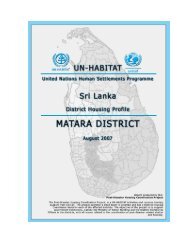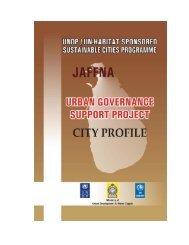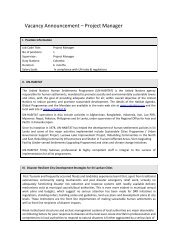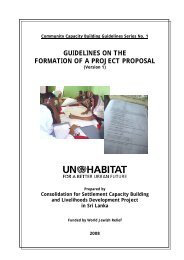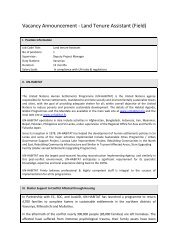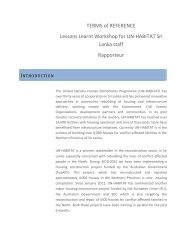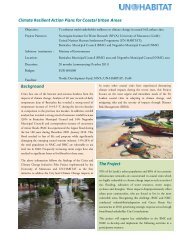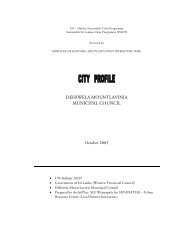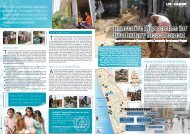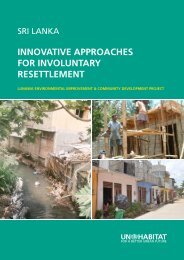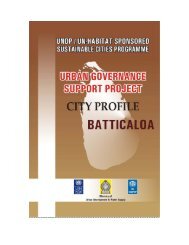<strong>Turning</strong> <strong>Sri</strong> Lanka’s <strong>Urban</strong> <strong>Vision</strong> <strong>into</strong> <strong>Policy</strong> <strong>and</strong> <strong>Action</strong>Box 3 Underserved settlements in <strong>Sri</strong> Lanka’s urban areasBased on the 2011 UDA’s survey of Colombo, an estimated 68,812 households live in 1,499 underserved settlements,equivalent to more than half the city’s population. These settlements tend to be small <strong>and</strong> scattered, <strong>and</strong> about 74percent of them have less than 50 housing units. 1 The living conditions <strong>and</strong> the status of the housing stock are generallynot comparable to those in the slums of other South Asian megacities, such as Mumbai <strong>and</strong> Dhaka. Still, availableevidence indicates that subst<strong>and</strong>ard living conditions in underserved settlements has become a pressing issue inColombo.A survey of the city’s flood-prone underserved settlements, which are among the worst in living conditions, findsthat 81 percent of the housing structures in the shanty areas are permanent. The materials used for walls, flooring,<strong>and</strong> roofing are largely bricks, cement, <strong>and</strong> asbestos, respectively. However, the quality of construction varies <strong>and</strong> theinfirmity of the ground on which it has been built (canal reservations) is perceived to damage the cement floors, withobserved tilting of houses <strong>and</strong> cracks on the floor <strong>and</strong> walls. Lack of security of tenure is the norm in the shanties. About90 percent of the surveyed communities live on l<strong>and</strong> owned either by the municipal council or the government, though56 percent of them claim to have a user permit.The facilities available in the surveyed shanty areas have improved, when comparing results with those from the ColomboCity Poverty Profile of 2001. 2 Water is one of the services that has most improved. Of the surveyed households, 82percent (44 percent in 2001) reported that they now have individual connections <strong>and</strong> 90 percent (55 percent in 2001)receive adequate water throughout the day. Inner access roads, a more serious concern in the surveyed communities,are much worse than in 2001. Many inner access roads in the shanties are narrow <strong>and</strong> have been further narrowedby encroaching communities who extend their houses onto the pathway. Latrines <strong>and</strong> sewerage constitute one of thebiggest issues faced by shanty dwellers. The sharing of toilets results in many difficulties, <strong>and</strong> the poor connection tothe sewerage system results in overflows, especially during rain <strong>and</strong> flood periods, creating health hazards. Seventy-sixpercent of the residents surveyed have been affected by recent floods. Households have developed coping mechanismsthat help them reduce the economic losses associated with flooding. For example, houses are being built at raised levelsor a raised wall is built where water can seep, such as through doors. In addition, to reduce the impact of floods onhousehold items <strong>and</strong> to manage limited space, many of the surveyed households are building additional floors.Evidence indicates that cities <strong>and</strong> towns outside the Western Province are not spared from the challenge of underservedsettlements. For example, in Matara, 17 percent of the housing stock is deemed to be unsanitary, due to the use of lowqualitymaterial <strong>and</strong> unsafe locations. In K<strong>and</strong>y, 18 percent of the population lives in 3,602 low-income housing unitsin 45 underserved settlements. 3 Nuwara Eliya has more than 7,000 temporary houses constructed with nonpermanentmaterials, equivalent to about 20 percent of the total housing stock. 4 The suburban cities of Colombo, such as Dehiwala-Mount Lavinia, Kollonnawa, Kotte, Moratuwa, <strong>and</strong> Wattala, have on average 10–15 percent of their urban housing stockat subst<strong>and</strong>ard quality.Notes:1. <strong>Sri</strong> Lanka <strong>Urban</strong> Development Authority 2011; Sevanatha 2002.2. The 2001 Colombo City Poverty Profile however includes all settlements.3. <strong>Sri</strong> Lanka <strong>Urban</strong> Development Authority 2002.4. <strong>Sri</strong> Lanka <strong>Urban</strong> Development Authority 2004.Source: <strong>UN</strong>-<strong>HABITAT</strong>, CEPA, <strong>and</strong> Sevanatha 2012; <strong>Urban</strong> Development Plans of <strong>Sri</strong> Lanka’s cities.26
Chapter FourChapter4The challenges aheadThe System of Competitive Cities <strong>Vision</strong> is challenged in three main areas. First, the limitations of functions<strong>and</strong> resources, under which <strong>Urban</strong> Local Authorities (ULA) operate, are not conducive to efficienturban planning or the delivery of municipal services. Second, urbanization patterns, characterizedby low-density sprawl <strong>and</strong> ribbon development, are inefficient for service delivery, environmentallyunsustainable, <strong>and</strong> a constraint for exploiting the economic drivers of cities. Third, cities face bottlenecksin connective <strong>and</strong> municipal infrastructure due to investment backlogs <strong>and</strong> growing dem<strong>and</strong>.Challenges facing the Adequate <strong>and</strong> Affordable <strong>Urban</strong> Shelter for All <strong>Vision</strong> also fall under threemain heads. First, the government lacks a coherent long-term policy that defines its role in guiding,stimulating, <strong>and</strong> regulating the low-income housing market. Second, supply constraints affecting l<strong>and</strong>management <strong>and</strong> regulation, as well as transport infrastructure bottlenecks, inhibit the developmentof a housing market. Third, the housing-finance system for both bankable <strong>and</strong> nonbankable householdshas weaknesses. Together these factors drive up the cost of low-income housing, forcing most lowincomefamilies to find informal solutions.Systemic institutional <strong>and</strong> policy constraints – in city management <strong>and</strong> finance, planning, l<strong>and</strong>, <strong>and</strong>housing development – <strong>and</strong> physical infrastructure bottlenecks are the main challenges for developing<strong>Sri</strong> Lanka’s cities to their full potential.System of Competitive Cities <strong>Vision</strong>Limitations of municipal authority <strong>and</strong> resourcesULAs operate under limitations of functions <strong>and</strong> resources. Achieving the Mahinda Chintana <strong>Urban</strong><strong>Vision</strong> depends on the ULAs having the capacity to carry out their functions <strong>and</strong> deliver high-qualityservices to their constituents. Yet ULAs are constrained because urban service delivery <strong>and</strong> planningare largely centralized <strong>and</strong> fragmented <strong>and</strong> have inadequate incentives, funds, <strong>and</strong> human resourcesto carry out their functions.Responsibilities for urban service delivery are largely centralized. The allocation of functions acrosstiers of government follows the 13th Amendment to the Constitution in 1987, with the provision thatlocal authorities retain their powers <strong>and</strong> functions under existing laws. 68 In practice, the exerciseof functions across government tiers is the result of a complex adjustment between imperatives ofcentralization <strong>and</strong> decentralization. The scope of services provided by urban authorities in realityvaries greatly among ULAs, based on their financial situation. Central government agencies havegradually taken over most of the public utility functions that had been assigned to ULAs by law, suchas water supply. 69 The National Water Supply <strong>and</strong> Drainage Board (NWSDB) is responsible for water27



